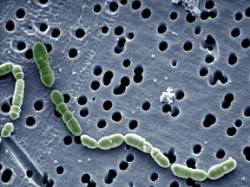Eubacteria
Online Biology Dictionary
|
|

|
| Oenococcus oeni, a gram-positive bacterium |
From a taxonomic standpoint Eubacteria is now an obsolete term. Formerly, it was widely used to refer to one of the two known types of prokaryotes and the name archaebacteria was used to refer to the other.
But then it was found that eubacteria differed from archaebacteria with respect to their ribosomal RNA sequences as much as either does from eukaryotes. In 1977 Carl Woese, an American microbiologist, asserted that the taxonomic treatment of the two should reflect the level of difference seen in the sequences. This view eventually won out. As a result, most texts now use the term Archaea in place of Archaebacteria, while the other former category of prokaryotes is now called simply Bacteria. The two are now usually treated as separate kingdoms.
This practice is confusing because it requires the use of the name bacteria to refer to only a subset of the set of organisms that have traditionally been called bacteria. Nevertheless, in the remainder of this section "bacteria" will be used only in this narrow, recent sense.
Bacteria come in a wide variety of shapes, but most fall under one of five headings: spheres (cocci), rods (bacilli), curved rods (vibrio), spirals (spirochetes), tight coils (spirilla).
Bacterial cells are about one tenth the size of eukaryotic cells and are typically 0.5-5.0 micrometers in length. However, some — for example the gram-positive coccus Thiomargarita namibiensis — can be as much as 500 micrometers long. These are visible to the naked eye. Perhaps the smallest bacteria are the mycoplasmids, only 0.3 micrometers long, about the size of a large virus.
Most shared on Macroevolution.net:
Human Origins: Are we hybrids?
On the Origins of New Forms of Life
Mammalian Hybrids
Cat-rabbit Hybrids: Fact or fiction?
Famous Biologists
Dog-cow Hybrids
Georges Cuvier: A Biography
Prothero: A Rebuttal
Branches of Biology
Dog-fox Hybrids